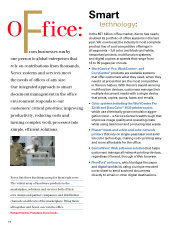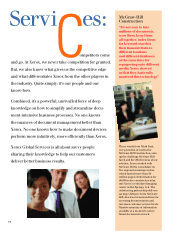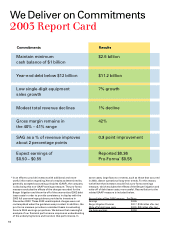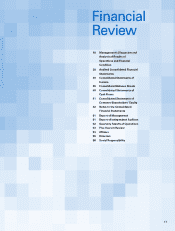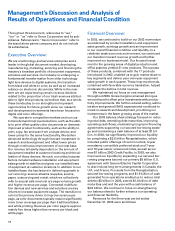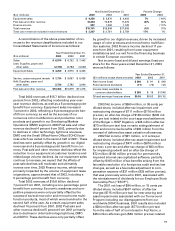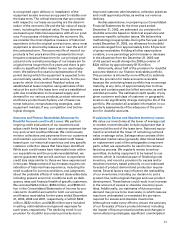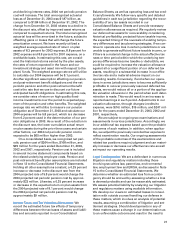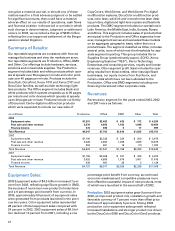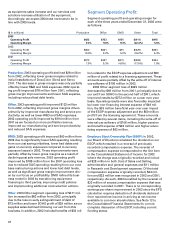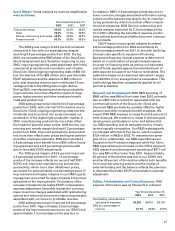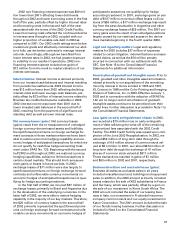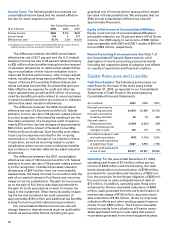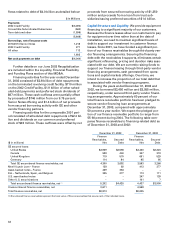Xerox 2003 Annual Report Download - page 24
Download and view the complete annual report
Please find page 24 of the 2003 Xerox annual report below. You can navigate through the pages in the report by either clicking on the pages listed below, or by using the keyword search tool below to find specific information within the annual report.
22
changes in demand or technological developments
could materially impact the value of our inventory and
our reported operating results if our estimates prove
to be inaccurate. We recorded $78 million, $115 mil-
lion, and $242 million in inventory write-down charges
for the years ended December 31, 2003, 2002 and 2001,
respectively. The decline in inventory write-down
charges is due to the absence of business exiting activ-
ities, stabilization of our product lines, manufacturing
outsourcing related improvements and a lower level
of inventories.
As discussed above, in preparing our financial
statements for the three years ended December 31,
2003, we estimated our provision for excess and obso-
lete inventories based primarily on forecasts of pro-
duction and service requirements. We believe this
methodology is appropriate. During the three year
period ended December 31, 2003, inventory reserves
for net realizable value adjustments as a percentage of
gross inventory varied by approximately one percent-
age point. Holding all other assumptions constant, a
0.5 percentage point increase or decrease in our net
realizable value adjustments would change the 2003
provision of $78 million by approximately $7 million.
Asset Valuations and Review for Potential
Impairments: Our long-lived assets, excluding good-
will, are assessed for impairment by comparison of
the total amount of undiscounted cash flows expected
to be generated by such assets to their carrying value.
We periodically review our long-lived assets, whereby
we make assumptions regarding the valuation and the
changes in circumstances that would affect the carry-
ing value of these assets. If such analysis indicates
that an impairment exists, we are then required to
estimate the fair value of the asset and, as appropriate,
expense all or a portion of the asset, based on a com-
parison to the net book value of such asset or group of
assets. The determination of fair value includes inher-
ent uncertainties, such as the impact of competition
on future value. Our primary methodology for deter-
mining fair value is based on a discounted cash flow
model. We believe that we have made reasonable esti-
mates and judgments in determining whether our
long-lived assets have been impaired; however, if
there is a material change in the assumptions used in
our determination of fair values or if there is a material
change in economic conditions or circumstances influ-
encing fair value, we could be required to recognize
certain impairment charges in the future. During 2002,
due to our decision to abandon the use of certain soft-
ware applications, we recorded an impairment charge
of $106 million in Selling, administrative and general
expenses in the accompanying Consolidated
Statement of Income. In addition, we recorded asset
impairment charges in connection with our restructur-
ing actions of $1 million, $55 million, and $205 million
in 2003, 2002, and 2001, respectively.
Goodwill and Other Acquired Intangible Assets: We
have made acquisitions in the past that included the
recognition of a significant amount of goodwill and
other intangible assets. Commencing January 1, 2002,
goodwill is no longer amortized, but instead is
assessed for impairment annually or more frequently
as triggering events occur that indicate a decline in fair
value below that of its carrying value. In making these
assessments, we rely on a number of factors including
operating results, business plans, economic projec-
tions, anticipated future cash flows and market compa-
rable data. There are inherent uncertainties related to
these factors and our judgment, including the risk that
the carrying value of our goodwill may be overstated
or understated. In 2002, we recognized an impairment
charge of $63 million related to the goodwill in our
DMO segment, which was recorded as a cumulative
effect of a change in accounting principle in the accom-
panying Consolidated Statements of Income.
Pension and Post-retirement Benefit Plan
Assumptions: We sponsor pension plans in various
forms in several countries covering substantially all
employees who meet eligibility requirements. Post-
retirement benefit plans cover primarily U.S. employ-
ees for retirement medical costs. Several statistical
and other factors that attempt to anticipate future
events are used in calculating the expense, liability
and asset values related to our pension and post-
retirement benefit plans. These factors include
assumptions we make about the discount rate, expect-
ed return on plan assets, rate of increase in healthcare
costs, the rate of future compensation increases and
mortality, among others. For purposes of determining
the expected return on plan assets, we utilize a calcu-
lated value approach in determining the value of the
pension plan assets, as opposed to a fair market value
approach. The primary difference between the two
methods relates to a systematic recognition of
changes in fair value over time (generally two years)
versus immediate recognition of changes in fair value.
Our expected rate of return on plan assets is then
applied to the calculated asset value to determine the
amount of the expected return on plan assets to be
used in the determination of the net periodic pension
cost. The calculated value approach reduces the
volatility in net periodic pension cost that results from
using the fair market value approach. The difference
between the actual return on plan assets and the
expected return on plan assets is added to, or sub-
tracted from, any cumulative differences that arose in
prior years. This amount is a component of the unrec-
ognized net actuarial (gain) loss and is subject to
amortization to net periodic pension cost over the
average remaining service lives of the employees par-
ticipating in the pension plan.
As a result of cumulative asset returns being lower
than expected asset returns over the last several years


